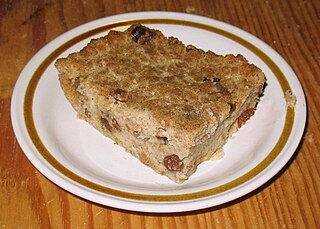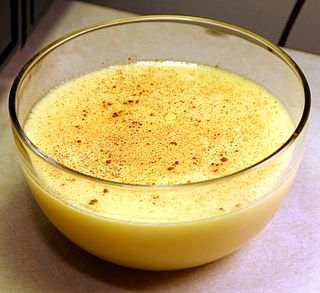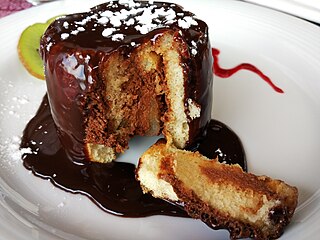Related Research Articles

Dessert is a course that concludes a meal. The course consists of sweet foods, such as cake, biscuit, ice cream and possibly a beverage such as dessert wine and liqueur. Some cultures sweeten foods that are more commonly savory to create desserts. In some parts of the world there is no tradition of a dessert course to conclude a meal.

Bread pudding is a bread-based dessert popular in many countries' cuisines. It is made with stale bread and milk or cream, generally containing eggs, a form of fat such as oil, butter or suet and, depending on whether the pudding is sweet or savory, a variety of other ingredients. Sweet bread puddings may use sugar, syrup, honey, dried fruit, nuts, as well as spices such as cinnamon, nutmeg, mace, or vanilla. The bread is soaked in the liquids, mixed with the other ingredients, and baked.

Custard is a variety of culinary preparations based on sweetened milk, cheese, or cream cooked with egg or egg yolk to thicken it, and sometimes also flour, corn starch, or gelatin. Depending on the recipe, custard may vary in consistency from a thin pouring sauce to the thick pastry cream used to fill éclairs. The most common custards are used in custard desserts or dessert sauces and typically include sugar and vanilla; however, savory custards are also found, e.g., in quiche.

Porridge is a food made by heating or boiling ground, crushed or chopped starchy plants, typically grain, in milk or water. It is often cooked or served with added flavourings such as sugar, honey, fruit, or syrup to make a sweet cereal, or it can be mixed with spices, meat, or vegetables to make a savoury dish. It is usually served hot in a bowl, depending on its consistency. Oat porridge, or oatmeal, is one of the most common types of porridge. Gruel is a thinner version of porridge and congee is a savoury variation of porridge of Asian origin.

Pudding is a type of food. It can be either a dessert, served after the main meal, or a savoury dish, served as part of the main meal.

A soufflé is a baked egg dish originating in France in the early 18th century. Combined with various other ingredients, it can be served as a savoury main dish or sweetened as a dessert. The word soufflé is the past participle of the French verb souffler, which means to blow, breathe, inflate or puff.

Rice pudding is a dish made from rice mixed with water or milk and commonly other ingredients such as sweeteners, spices, flavourings and sometimes eggs.

Ukrainian cuisine is the collection of the various cooking traditions of the people of Ukraine, one of the largest and most populous European countries. It is heavily influenced by the rich dark soil (chornozem) from which its ingredients come, and often involves many components. Traditional Ukrainian dishes often experience a complex heating process – "at first they are fried or boiled, and then stewed or baked. This is the most distinctive feature of Ukrainian cuisine".

Pennsylvania Dutch cuisine is the typical and traditional fare of the Pennsylvania Dutch. According to one writer, "If you had to make a short list of regions in the United States where regional food is actually consumed on a daily basis, the land of the Pennsylvania Dutch—in and around Lancaster County, Pennsylvania—would be at or near the top of that list," mainly because the area is a cultural enclave of Pennsylvania Dutch culture.

Queen of Puddings is a traditional British dessert, consisting of a baked, breadcrumb-thickened egg mixture, spread with jam and topped with meringue. Similar recipes are called Monmouth Pudding and Manchester Pudding.
Hasty pudding is a pudding or porridge of grains cooked in milk or water. In the United States, it often refers specifically to a version made primarily with ground ("Indian") corn, and it is mentioned in the lyrics of "Yankee Doodle", a traditional American song of the 18th century.
Mithai (sweets) are the confectionery and desserts of the Indian subcontinent. Thousands of dedicated shops in India, Bangladesh, Nepal, Pakistan and Sri Lanka sell nothing but sweets.

A charlotte is a type of bread pudding that can be served hot or cold. It is also referred to as an "icebox cake". Bread, sponge cake, crumbs or biscuits/cookies are used to line a mold, which is then filled with a fruit puree or custard. The baked pudding could then be sprinkled with powdered sugar and glazed with a salamander, a red-hot iron plate attached to a long handle, though modern recipes would likely use more practical tools to achieve a similar effect.

An apple dumpling is a baked or boiled pastry-wrapped apple. To prepare apple dumplings, apples are peeled, cored and sometimes quartered and placed on a portion of dough. The hole from the core may be filled with cinnamon, butter and sugar and sometimes dried fruit such as raisins, sultanas, or currants. The dough is folded over the apples and sealed. Sometimes a spiced sauce is poured over the dumplings which are then baked until tender; the sugar and butter create a sweet sauce. Apple dumplings can be served hot, cold, or room temperature for breakfast, dessert, or as a main dish.

Bobotie is a South African dish consisting of spiced minced meat baked with an egg-based topping.

Bread and butter pudding is a traditional bread pudding in British cuisine. Slices of buttered bread scattered with raisins are layered in an oven dish, covered with an egg custard mixture seasoned with nutmeg, vanilla, or other spices, then baked.

Sponge cake is a light cake made with eggs, flour and sugar, sometimes leavened with baking powder. Some sponge cakes do not contain egg yolks, like angel food cake, but most of them do. Sponge cakes, leavened with beaten eggs, originated during the Renaissance, possibly in Spain. The sponge cake is thought to be one of the first non-yeasted cakes, and the earliest attested sponge cake recipe in English is found in a book by the English poet Gervase Markham, The English Huswife, Containing the Inward and Outward Virtues Which Ought to Be in a Complete Woman (1615). Still, the cake was much more like a cracker: thin and crispy. Sponge cakes became the cake recognised today when bakers started using beaten eggs as a rising agent in the mid-18th century. The Victorian creation of baking powder by English food manufacturer Alfred Bird in 1843 allowed the addition of butter to the traditional sponge recipe, resulting in the creation of the Victoria sponge. Cakes are available in many flavours and have many recipes as well. Sponge cakes have become snack cakes via the Twinkie.

Muhallebi is a milk pudding commonly made with rice, sugar, milk and either rice flour, starch or semolina, popular as a dessert in the Turkey and Middle East. While the dessert is called Muhallebi in Turkey and Iraq, the Egyptian variant is called mahalabia, the levantine variant is called mahalabiyeh.
Romani cuisine is the cuisine of the ethnic Romani people. There is no specific "Roma cuisine"; it varies and is culinarily influenced by the respective countries where they have often lived for centuries. Hence, it is influenced by European cuisine even though the Romani people originated from the Indian subcontinent. Their cookery incorporates Indian and South Asian influences, but is also very similar to Hungarian cuisine. The many cultures that the Roma contacted are reflected in their cooking, resulting in many different cuisines. Some of these cultures are Middle European, Germany, Great Britain, and Spain. The cuisine of Muslim Romani people is also influenced by Balkan cuisine and Turkish cuisine. Many Roma do not eat food prepared by a non-Roma.
Pie in American cuisine has roots in English cuisine and has evolved over centuries to adapt to American cultural tastes and ingredients. The creation of flaky pie crust shortened with lard is credited to American innovation.
References
- ↑ American Cookery (1796) by Amelia Simmons
- ↑ "Ipswich Almond Pudding". The Foods of England Project.
- ↑ "Almond Breadcrumb Pudding". The Foods of England Project.
- ↑ "Almond Custard Pudding". The Foods of England Project.
- ↑ "Badam Kheer Recipe". Times of India.